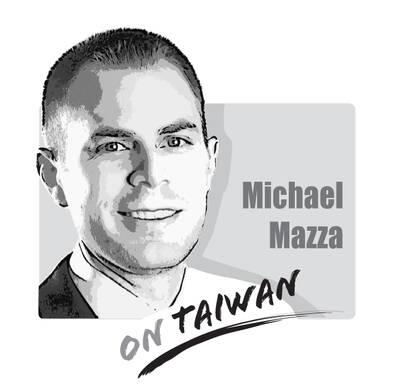As heavy rains once again caused flooding in parts of Kaohsiung and Tainan, some academics have advocated a focus on flood control. However, the government has been pushing flood control for decades.
From the flood prevention plan for Taipei and New Taipei City, the flood-prone area management plan and the comprehensive river basin management plan to the Forward-looking Infrastructure Development Program, the government has spent more than NT$1 trillion (US$33.87 billion) on flood control measures.
Why are torrential rains always followed by a war of words?
The public has called for better flood control as society continues to develop. To carry out flood control properly, it is necessary to first understand what a flood disaster is.
The government’s Categories and Standards of Assistance for Flood Disasters says that a flood disaster has occurred when flood water reaches a depth of 50cm in households or when farms and fish farms are destroyed by rain.
During the recent heavy rains in southern Taiwan, local residents found the situation unbearable when flood waters in the affected areas were about 20cm to 30cm deep.
It is clear that economic development has sharply weakened the public’s ability to endure a natural disaster.
This raises the question of whether the government should redefine what constitutes a flood disaster, in terms of the flooding of an area and water accumulated in a residence.
Any flood control plan includes standards and limitations. Drainage systems are only designed for 10-year flood return periods.
In addition, the “freeboard” — the height above the recorded high-water mark — protection standard is usually designed for 25 years at most, based on analysis of past hydrological data.
Adding the two together produces the maximum protection standard.
Taking climate change into consideration, the chance of heavy rains is likely to continue to rise. It would require land and engineering funds to build more flood detention ponds, floodways and dikes.
As flooding currently only occurs three to five days every year, the question is whether it is worth setting aside a huge budget for flood control infrastructure, and whether the public would be willing to support such construction if it requires land expropriation.
In light of budget limitations, people face the question of whether to prevent less serious flooding in their own neighborhood or more serious flooding in another neighborhood. As this involves private interests and the distribution of resources, failure to build public consensus on such issues could result in a public outcry after every flood.
In 2018, “Chapter 7-1: Runoff Allocation and Outflow Control” was added to the Water Act (水利法) to reinforce the need to put one’s own house in order.
It might be more difficult to improve the flooding problem in urban areas. Apart from basic work such as cleaning the gutters to prevent blockages, it would be more feasible to encourage the public to install rainwater tanks and increase permeable surfaces on public land in an attempt to build a “sponge” city that can absorb water.
Rural areas could start by converting communities into disaster-resistant areas, and deploying hydrological monitoring systems and water pumps to reduce flood damage.
A flood disaster is a natural phenomenon that causes losses. It is necessary to learn how to coexist with flooding and to stop dreaming about completely eliminating it.
Chang Yen-ming is a former director of the Water Resources Agency’s Taichung branch.
Translated by Eddy Chang

Could Asia be on the verge of a new wave of nuclear proliferation? A look back at the early history of the North Atlantic Treaty Organization (NATO), which recently celebrated its 75th anniversary, illuminates some reasons for concern in the Indo-Pacific today. US Secretary of Defense Lloyd Austin recently described NATO as “the most powerful and successful alliance in history,” but the organization’s early years were not without challenges. At its inception, the signing of the North Atlantic Treaty marked a sea change in American strategic thinking. The United States had been intent on withdrawing from Europe in the years following
My wife and I spent the week in the interior of Taiwan where Shuyuan spent her childhood. In that town there is a street that functions as an open farmer’s market. Walk along that street, as Shuyuan did yesterday, and it is next to impossible to come home empty-handed. Some mangoes that looked vaguely like others we had seen around here ended up on our table. Shuyuan told how she had bought them from a little old farmer woman from the countryside who said the mangoes were from a very old tree she had on her property. The big surprise
The issue of China’s overcapacity has drawn greater global attention recently, with US Secretary of the Treasury Janet Yellen urging Beijing to address its excess production in key industries during her visit to China last week. Meanwhile in Brussels, European Commission President Ursula von der Leyen last week said that Europe must have a tough talk with China on its perceived overcapacity and unfair trade practices. The remarks by Yellen and Von der Leyen come as China’s economy is undergoing a painful transition. Beijing is trying to steer the world’s second-largest economy out of a COVID-19 slump, the property crisis and
Former president Ma Ying-jeou’s (馬英九) trip to China provides a pertinent reminder of why Taiwanese protested so vociferously against attempts to force through the cross-strait service trade agreement in 2014 and why, since Ma’s presidential election win in 2012, they have not voted in another Chinese Nationalist Party (KMT) candidate. While the nation narrowly avoided tragedy — the treaty would have put Taiwan on the path toward the demobilization of its democracy, which Courtney Donovan Smith wrote about in the Taipei Times in “With the Sunflower movement Taiwan dodged a bullet” — Ma’s political swansong in China, which included fawning dithyrambs